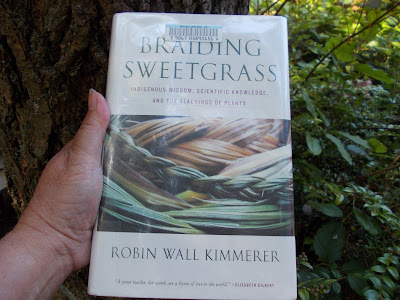 |
| airing out the banner on the fence at home |
Here's our
intended flow of pule, welcome, and ceremony for Open House
... somethings may change, while others stay the same
Pule Ho'ulu'ulu (
Prayer to the Ancestors)
Blessing with 'olena (Hawaiian turmeric) and ocean water
Aloha mai nei kakou, mahalo na aumakua
Greetings, Welcome and Thank-you
E Ho Mai
(asking and preparing our hearts and minds to listen)
Listen and repeat
"The Words Before All Else"
(From Braiding Sweetgrass written by Robin Wall Kimmerer
This text translated from the Onandaga language by John Stokes and Kanawahientun, 1993)
All participate
"Why we are here" Song
Tulalilip Lushootseed Language Department
Describing the set-up for today's activities
and sharing our vision for HO'OMOKU ... making island
He puko'a kani 'aina
A coral reef that grows into an island.
A person beginning in a small way gains steadily until firmly established.
(Kupuna words of wisdom 'Olelo No'eau upon which Ho'omoku is built)
Niuola (water of life, the coconut)
The story, the drink, the gift
"I am the descendants of (fill in the blank) survivors."
(the bowls of salt and making of bundles)
Ceremony of introductions one-to-one
Mea 'Ai (Lunch)
Kupe'e/Lei la'i (braiding bracelets/lei of la'i)
Braiding with another person
Hulo ('olelo Hawaii vocabulary game)
Fun way to building your Hawaiian vocabulary
Special mahalo to
Christopher Kawika Brown our son from Antony, France for the HO'OMOKU Logo
Kaliko Amona our cousin from Pupukea, Oahu for the gathering, cleaning and shipping of La'i
Jude Bierman our dear friend from the Maxwelton Valley for the financial support to grow HO'OMOKU
Pete Little my husband and co-conspirator in this life for his mending, meddling magic and love
The South Whidbey TILTH Community and Board of Directors, especially Prescott for their commitment to our vision to encourage and create chemical and fragrance free public spaces
The Tulalip Lushootseed Language Department for sharing the First Names of this place, and the place where Pete and I live
Eric and the members of the Langley STAR Store produce department
for making it possible to enjoy
our young niuola
The box of 100 la'i arrived Thursday morning. We opened the box that evening before the Opening Ceremony.
Linda and Dawn sort the leaves by size
Showing how to 'bone' the leaves to get the soft sides for braiding
After the sides have been set into a pot of boiling water to soften, the haumana braid between them



















































